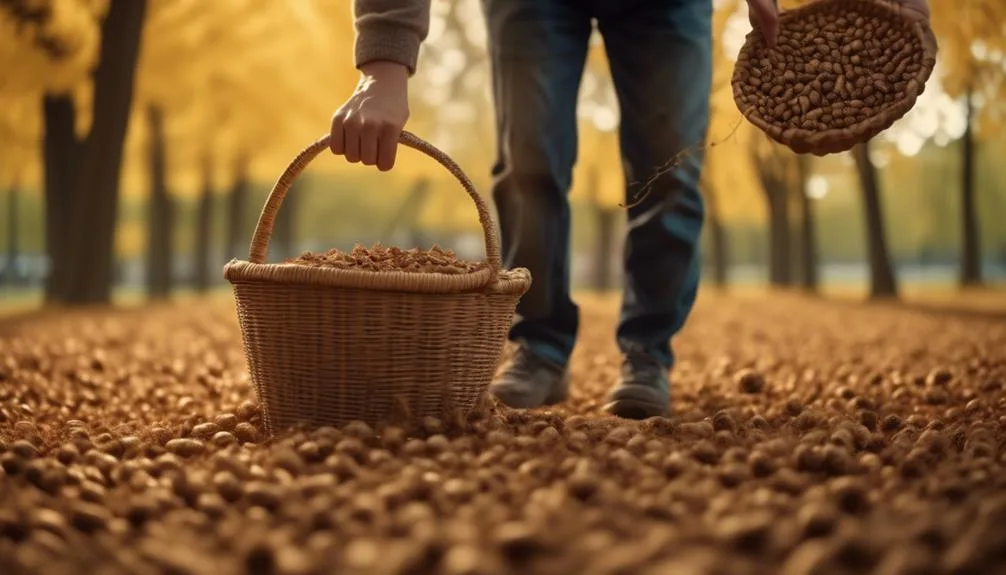Harvesting elm tree seeds can be a bit tricky, but it's well worth it. Whether you're an experienced gardener or just starting out, knowing the best methods for collecting elm tree seeds is key for successful tree growing.
Let's look at the important factors that can affect the quality of your seed collection and, ultimately, the success of your elm tree cultivation.
Timing for Seed Collection
When collecting elm tree seeds, it's crucial to harvest them at the right time to ensure the best chances of successful germination. Optimal conditions for harvesting elm tree seeds involve waiting until late spring or early summer when the seeds have reached full maturity. At this stage, the seeds will be a light brown color and easily detach from the tree.
It's important to gather the seeds before they start to fall naturally, as they can be susceptible to damage or predation on the ground. By harvesting elm tree seeds at the peak of their maturity, you increase the likelihood of successful germination and ensure that the seeds are in the best condition for propagation.
Timing is essential for securing healthy seeds for future growth.
Identifying Ripe Elm Tree Seeds
To identify ripe elm tree seeds, look for seeds that are a light brown color and easily detach from the tree. Seed maturity is crucial for successful propagation, so it's important to be able to recognize when the seeds are at their peak for harvesting. Visually, ripe elm tree seeds are light brown and may have a papery wing attached. They should feel dry and not pliable when gently squeezed. Here's a quick visual guide to help you identify ripe elm tree seeds:
| Visual Characteristics | Description |
|---|---|
| Color | Light brown |
| Attachment | Easily detachable |
| Texture | Dry, not pliable |
| Wing | Papery, may be present |
| Shape | Oval or round |
Efficient Seed Collection Techniques
Now that you've identified the ripe elm tree seeds, it's essential to employ efficient techniques for harvesting them to ensure successful propagation.
When collecting the seeds, it's crucial to gather them before they disperse naturally. A practical method is to use a tarp or sheet under the tree to catch falling seeds and then carefully transfer them into a container. This prevents the seeds from scattering and increases the efficiency of the collection process.
Additionally, select seeds that are plump and free from mold or damage. After harvesting, store the seeds in a cool, dry place to maintain their viability for germination.
Efficient seed collection not only ensures a successful harvest but also promotes healthy seed dispersal and optimal seed germination.
Proper Storage of Elm Tree Seeds
For optimal preservation of elm tree seeds, ensure that they're stored in a cool, dry environment. Seed preservation is crucial to maintain the viability of the seeds.
After harvesting, it's important to dry the seeds thoroughly to prevent moisture-related issues during storage. Place the seeds in a breathable container, such as a paper bag, to allow any remaining moisture to escape. Keep the container in a cool, dry location, ideally with a consistent temperature and low humidity.
Moisture control is essential to prevent mold growth and seed decay. Check the seeds regularly for any signs of mold or moisture, and discard any damaged ones to avoid affecting the entire batch.
Maximizing Seed Viability
Ensuring optimal viability of elm tree seeds requires diligent attention to storage conditions and regular monitoring for any signs of mold or moisture. Proper seed storage is crucial for maintaining seed viability.
Store the seeds in a cool, dry place, preferably in a breathable container such as a paper bag. Avoid plastic bags, as they can trap moisture.
Check the seeds regularly for any signs of mold or decay, and discard any damaged seeds to prevent the spread of issues.
Additionally, periodic monitoring of the germination process can help assess the viability of the seeds.
Conclusion
Incorporating these methods for harvesting elm tree seeds ensures efficient collection and optimal storage for future planting.
By following these techniques, you can contribute to the preservation of these vital trees.
Ready to start harvesting and making a difference?

My interest in trees started when I first saw the giant sequoias in Yosemite.
I was a teenager then, and I remember thinking, “I need to learn more about this.”
That moment stuck with me.
A few years later, I went on to study forestry at Michigan Tech.
Since graduating, I’ve worked in a mix of hands-on tree care and community education.
I’ve spent over ten years helping people understand how to plant, maintain, and protect the trees in their neighborhoods.
I don’t see trees as just part of the landscape.
They are living things that make a real difference in our daily lives.
